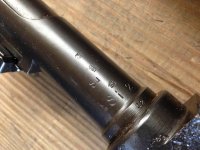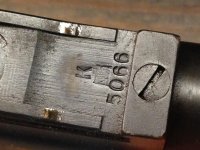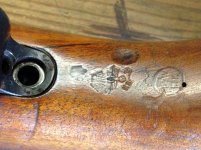Picked this up not too long ago and thought I would share with the group. Rifle is a bolt mismatch, and the stock is renumbered. All metal otherwise is matching.
I found the condition of the receiver interesting, that they salvaged the receiver given how bad the pitting is.
Interestingly the stock appears to be renumbered, but has the correct serial number in the barrel channel. I thought it was interesting that has Imperial, Weimar and Nazi stock markings. The stock was possibly replaced in WWI or during the Weimar era, it is hard to show in the picture, but the 5066 was stamped, worn thin, and restamped. Buttplate does not have any depot markings.
I have never seen the Ww Hr marking before, what is its meaning? I looked through Steves/Karem and here on the forum, but only a quick search.
My apologies some of the pictures came out fuzzy and for some reason rotated. Didn't have time to get the SLR and macro out.
I found the condition of the receiver interesting, that they salvaged the receiver given how bad the pitting is.
Interestingly the stock appears to be renumbered, but has the correct serial number in the barrel channel. I thought it was interesting that has Imperial, Weimar and Nazi stock markings. The stock was possibly replaced in WWI or during the Weimar era, it is hard to show in the picture, but the 5066 was stamped, worn thin, and restamped. Buttplate does not have any depot markings.
I have never seen the Ww Hr marking before, what is its meaning? I looked through Steves/Karem and here on the forum, but only a quick search.
My apologies some of the pictures came out fuzzy and for some reason rotated. Didn't have time to get the SLR and macro out.
Attachments
-
 IMG_7308.jpg291.6 KB · Views: 53
IMG_7308.jpg291.6 KB · Views: 53 -
 IMG_7309.jpg291 KB · Views: 67
IMG_7309.jpg291 KB · Views: 67 -
 IMG_7310.jpg292.7 KB · Views: 55
IMG_7310.jpg292.7 KB · Views: 55 -
 IMG_7311.jpg292.4 KB · Views: 42
IMG_7311.jpg292.4 KB · Views: 42 -
 IMG_7312.jpg296.6 KB · Views: 40
IMG_7312.jpg296.6 KB · Views: 40 -
 IMG_7313.jpg291.5 KB · Views: 35
IMG_7313.jpg291.5 KB · Views: 35 -
 IMG_7314.jpg292.5 KB · Views: 36
IMG_7314.jpg292.5 KB · Views: 36 -
 IMG_7315.jpg257.6 KB · Views: 41
IMG_7315.jpg257.6 KB · Views: 41 -
 IMG_7316.jpg255.3 KB · Views: 35
IMG_7316.jpg255.3 KB · Views: 35 -
 IMG_7317.jpg254.5 KB · Views: 35
IMG_7317.jpg254.5 KB · Views: 35
Last edited:




















